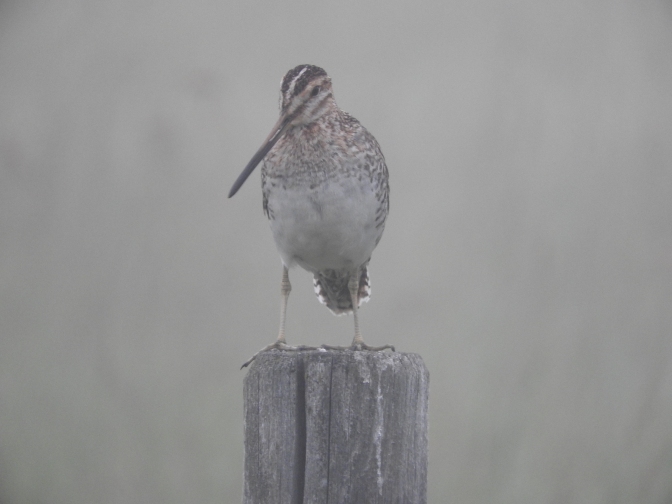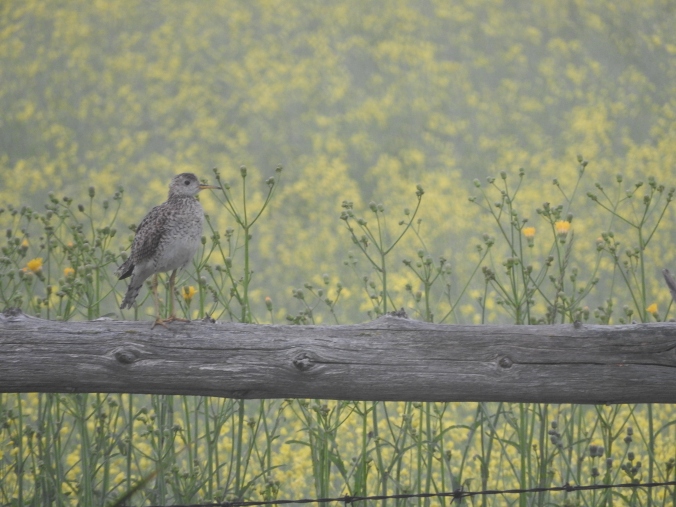It’s 4am and someones alarm in the house is ringing. Slowly a house of blitzers awake and get ready for a fun morning of birding that lies ahead. We have six groups ready to go in the morning to monitor all the birds of the Southwestern Mixed-Grass Prairie IBA. Rather than drive around an area in random order, we have distributed maps to each team with historic sightings of Sprague’s Pipit and Chestnut-collared Longspur which will help teams locate grasslands and make searching efficient. What could possibly go wrong? Ah, the now traditional thick mist which seems to follow IBA blitzes around, that’s what could go wrong (see here and here).

Luc and Tim trying to find birds out there. Somewhere. Photo copyright Donna Martin

A Swainson’s Hawk which has presumably lost its breakfast. Photo copyright Donna Martin

That clown, the Upland Sandpiper. Photo copyright Donna Martin

A Wilson’s Snipe, another typical prairie shorebird. Photo copyright Donna Martin
Well, we were in place and ready to go, and what’s a bit of mist to keep us from a morning of blitzing this fine corner of Manitoba. So instead bundled into different vehicles, we went on our merry way. The map below gives an idea of where we were with a sixth team, consisting of one individual, surveying private land with abundant grassland birds.

The drive from Reston to the IBA was therefore slightly fraught, not helped when I took the road to Melita rather Pierson and started a bit late. However once further east an incredible sunrise was developing and thankfully, unlike the old saying, the weather for the remainder of the day once the mist broke was perfect.

Stunning sunrise. Photo copyright Betsy Thorsteinson
For those groups in the west, the mist eventually began to lift….

You can just about see the fenceposts at the rear of this patch of grassland. note also how lush the grassland is, something you probably would not normally associate with somewhere know as the Poverty Plains, or indeed, the Banana Belt. Photo copyright to Garry Budyk
Christian Artuso was first out, the keener, and off to the Melita area. He would be meeting Jo Swartz and Betsy Thorsteinson in Melita (they eschewed the luxury of a house with no beds and spent the weekend in a hotel, crazy). Christian had a large walking section and would be meeting his team at regular spots over the route. They counted a very impressive 1832 individual birds representing 65 species. A great effort! They also found incredible numbers of grassland specialists including Baird’s Sparrow (15), Grasshopper Sparrow (38), Sprague’s Pipit (40) and Chestnut-collared Longspur (71).

Lost and the sun is still rising! Christian and Jo planning their escape. Photo copyright Betsy Thorsteinson
They also managed to re-find the Dickcissel


Echinacea. Photo copyright Christian Artuso
It goes without saying that IBA’s are wonderful places for birds. But what about other wildlife? Well, in the previous post I had already alluded to the flora and there is plenty on native grasslands.
When we think of grassland mammals native prairies, the most likely to come to mind would be the bison of the open plains. Another herbivore of the native prairies is the Mule Deer, a provincial Species At Risk. Our group were able to see a Mule Deer north of Lyleton. In the mist we could also see White-tailed Deer. Christian, Jo and Betsy had the mammalian highlight of the blitz with this amazing view of an American Badger.

An American Badger peering out of the grass. Photo copyright Christian Artuso
Garry Budyk and John Weier took on the central area and recorded 75 species. They had a good sweep of Sprague’s Pipit (10),a Loggerhead Shrike and a great mix of other species such as Savanna Sparrow (99), Le Conte’s Sparrow (29) and Orchard Oriole (13). Garry and John are both long-term volunteers for bird monitoring programs in Manitoba and a terrific help to the IBA Program.

Not his finest, but the Sprague’s Pipit is one of the most difficult species to see in Manitoba. This species can only usually be detected when it is singing high in the sky and is often not seen at all. This is a threatened species and has been designated as Vulnerable by IUCN and Threatened under the Canadian Species At Risk Act. Photo copyright Christian Artuso
Everyone detected Bobolink. This species has been designated as threatened in Canada by COSEWIC but is currently not listed as a Species At Risk. Bobolink are less sensitive to loss of native grassland habitats as other species and can readily be found in places like alfalfa fields. It is widespread in Manitoba but declining in the east, hence its current designation as threatened.

Female Bobolinks are sometimes difficult to pick out from the crowd of blackbirds whereas the males are possibly the most distinctive birds of the prairies bar the Western Meadowlark. This photo sums this fact up nicely, with the handsome male in the foreground and the indistinct female behind. Photo copyright Christian Artuso
The group in the northwest corner with Bonnie Chartier and new volunteers Pat and Dave Wally unfortunately ran into major issues with the roads. Very heavy rain in the previous week had effectively wiped out access to large parts of their area in the Poverty Plains. They still managed to find a Loggerhead Shrike and an elusive Baird’s Sparrow, plus 13 Chestnut-collared Longspur.

Christian Artuso had a thrilling moment when two elusive Baird’s Sparrow were singing either side of him. This little guy is obviously singing his heart out! Photo copyright Christian Artuso
The northwest team were Brandon locals Glennis Lewis and Gillian Richards. They were tasked with monitoring around the Broomhill WMA. They were the only group to catch a Ferruginous Hawk, two in fact. This was probably a pair which had already bred and were on territory preparing for 2017. Hope to see them then!

Ferruginous Hawk. Photo copyright Gillian Richards

Ferruginous Hawk. Photo copyright Gillian Richards

Ferruginous Hawk. Photo copyright Gillian Richards

Ferruginous Hawk. Photo copyright Gillian Richards

Ferruginous Hawk. Photo copyright Christian Artuso
Ferruginous Hawk is obviously the prize species in southern Manitoba, but it’s not the sole raptor recorded on the blitz. Both Red-tailed Hawk (total=41) and Swainson’s Hawk (total=17) were picked up in good numbers. The agile, graceful Northern Harrier soared over wetlands seeking prey. Also Bald Eagle, Turkey Vulture and American Kestrel graced the IBA.

Juvenile Red-tailed Hawk in a tree. Photo copyright Donna Martin

A second view of a juvenile Red-tailed Hawk, this time on a telegraph post. Photo copyright Garry Budyk
Another bird of prey which is easy to spot in southwestern Manitoba is the Great Horned Owl. If you are ever visiting this area in summer look around the outside of old barns for these night time hunters as they seem to select these sites for nesting.

A Great Horned Owl perched in the window of an old barn. Photo copyright Garry Budyk
Alex Froese from the Manitoba Burrowing Owl Recovery Program surveyed an extra area in the IBA on foot and found 51 Chestnut-collared Longspur and 2 Sprague’s Pipit. Thanks Alex!

A male Chestnut-collared Longspur in flight. This species is known for its fabulous display flights. Photo copyright Christian Artuso
Finally to the southeast group. Luc and I drove to Pierson where we were joined by locals Bill and Betty Warren. Starting out a wee bit later than expected thanks to my detour to Melita, we headed south towards Lyleton, checking out some longspur spots en route. The mist was, as previously stated, an issue and we struggled to pick up birds at our stops. It was pretty obvious that the longspurs would need a helping hand, and the conditions justified use of playback (playing the song on a portable speaker via bluetooth and a phone app). Fortunately for us, it did not take much enticing for the longspurs to begin singing. Interestingly, the Grasshopper Sparrows needed no such encouragement.

Grasshopper Sparrow on a wire with caterpillar in its mouth, presumably en route to feeding its young. We managed to pick up all Ammodramus sparrows in Manitoba (Grasshopper, Baird’s, Le Conte’s and Nelson’s). The Ammodramus sparrows are all typical of grassland and marshes and have relatively flat heads compared to other North American sparrows. Photo copyright Donna Martin
Reaching Lyleton, we met up with Joan Murray and at this point Donna Martin caught up with us. With a small convoy, we set off, picking up some more longspurs en route to Section 29. Luc also managed to pick up a faint, distant Sprague’s Pipit before we turned off. This area always proves to be a successful for finding grassland birds and today was no different, with good numbers of longspurs (although fewer than 2015), Grasshopper Sparrows galore and even 4 Baird’s Sparrow. Interestingly there were also Nelson’s Sparrow calling in a pasture, a good indication of wetland habitat and possibly revealing how much some of this area has changed in this wet cycle. Our return to Melita also took in Joan Murrays legendary yard, rich in songbirds.

Ground Plum or Buffalo Bean, a native plant of the prairies. Photo by Tim Poole

The grasses and shrubs in a native grassland should be relatively tall. Photo by Tim Poole

Possible Indian Breadroot (Psoralea esculenta). Happy to be corrected by someone more knowledgeable though. Photo copyright Tim Poole
Overall this blitz was a tremendous success. I will post a summary of the total number of birds encountered later today but for the meantime, here are the totals of the Species-At-Risk:
Ferruginous Hawk – 2
Loggerhead Shrike – 4
Spragues Pipit – 58
Chestnut-collared Longspur – 180
Grasshopper Sparrow – 88
Baird’s Sparrow – 21
Bobolink – 78

Go on then, one final Baird’s Sparrow – just it’s so hard to find these guys in Manitoba. Copyright Christian Artuso
Thank you to all our volunteers (in no particular order): Jo, Betsy, Dave and Pat, Bonnie, Garry, John, Glennis, Gillian, Luc, Donna, Bill, Betty, Joan, Alex and Christian.












































































